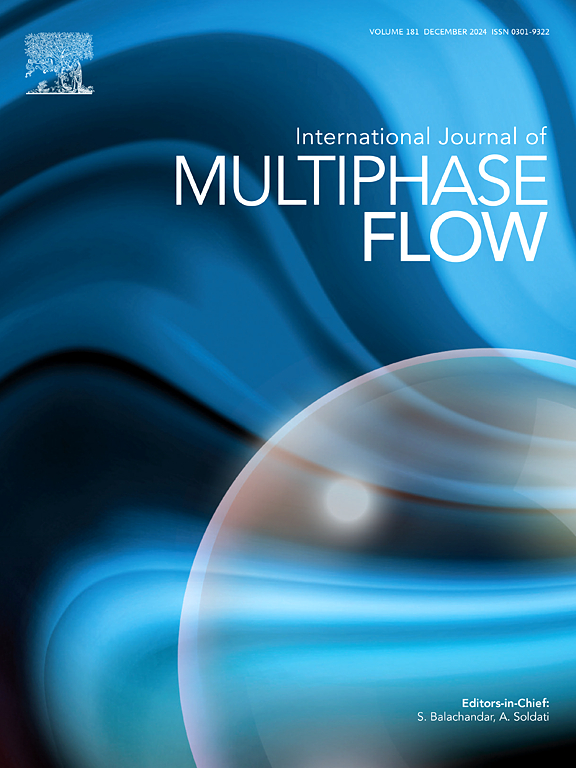Comparative analysis of volume of fluid and phase–field methods for numerical simulations of two-phase flows
IF 3.6
2区 工程技术
Q1 MECHANICS
International Journal of Multiphase Flow
Pub Date : 2025-04-19
DOI:10.1016/j.ijmultiphaseflow.2025.105245
引用次数: 0
Abstract
A comprehensive study is conducted to analyze various methods for capturing the fluid interface in numerical simulations of two-phase flows. The primary objective is to compare the performance of volume of fluid (VOF) methods, based on a sharp interface description, and phase-field (PF) methods, where diffuse transition layers are used instead. To this end, a series of numerical simulations is conducted by using an in-house solver with four different interface-capturing methods: an algebraic TVD-VOF (AVOF), a geometric PLIC-VOF (GVOF), and two PF methods, based respectively on the conservative Allen–Cahn (CAC) and profile-corrected Cahn–Hilliard (CCH) formulations. These simulations aim to reproduce commonly used benchmark test cases as well as more complex practical applications, such as oceanic wave breaking and the sloshing phenomena of fluids within containers. The results highlighted the strengths and weaknesses of each method under various conditions, offering insights into their accuracy and computational costs. Among the methods, the GVOF approach consistently demonstrated higher accuracy in predicting the interface geometry, along with superior grid convergence properties, making it a reliable choice for a wide range of numerical simulations. The AVOF method offers a reliable alternative, delivering accurate results but facing some challenges in capturing smaller fluid structures and showing performance degradation in highly nonlinear scenarios. The PF methods are less accurate in predicting interface geometry, but perform better in terms of surface tension accuracy, yielding reduced spurious currents. The CAC method proves computationally efficient and simple to implement but faces time step limitations that necessitate future improvement for high-fidelity simulations. Finally, the CCH method performs least accurately across test conditions and it also incurs the highest computational cost among the methods tested. These outcomes may provide valuable insights for researchers in selecting the most suitable numerical method for their specific applications.

流体体积法与相场法两相流数值模拟的比较分析
综合分析了两相流数值模拟中捕捉流体界面的各种方法。主要目的是比较基于清晰界面描述的流体体积法(VOF)和使用扩散过渡层的相场法(PF)的性能。为此,利用内部求解器进行了一系列数值模拟,采用四种不同的界面捕获方法:代数TVD-VOF (AVOF)、几何PLIC-VOF (GVOF)和两种PF方法,分别基于保守的Allen-Cahn (CAC)和轮廓校正的Cahn-Hilliard (CCH)公式。这些模拟旨在重现常用的基准测试案例以及更复杂的实际应用,例如海浪破碎和容器内流体的晃动现象。结果突出了每种方法在不同条件下的优缺点,并提供了对其准确性和计算成本的见解。其中,GVOF方法在预测界面几何形状方面一直表现出较高的精度,并且具有优越的网格收敛性能,使其成为广泛数值模拟的可靠选择。AVOF方法提供了一种可靠的替代方案,可以提供准确的结果,但在捕获较小的流体结构时面临一些挑战,并且在高度非线性的情况下表现出性能下降。PF方法在预测界面几何形状方面精度较低,但在表面张力精度方面表现较好,产生的杂散电流减少。CAC方法计算效率高,实现简单,但存在时间步长限制,需要进一步改进以实现高保真仿真。最后,CCH方法在各种测试条件下精度最低,计算成本也最高。这些结果可能为研究人员选择最适合其具体应用的数值方法提供有价值的见解。
本文章由计算机程序翻译,如有差异,请以英文原文为准。
求助全文
约1分钟内获得全文
求助全文
来源期刊
CiteScore
7.30
自引率
10.50%
发文量
244
审稿时长
4 months
期刊介绍:
The International Journal of Multiphase Flow publishes analytical, numerical and experimental articles of lasting interest. The scope of the journal includes all aspects of mass, momentum and energy exchange phenomena among different phases such as occur in disperse flows, gas–liquid and liquid–liquid flows, flows in porous media, boiling, granular flows and others.
The journal publishes full papers, brief communications and conference announcements.

 求助内容:
求助内容: 应助结果提醒方式:
应助结果提醒方式:


